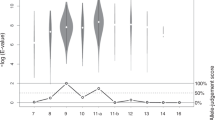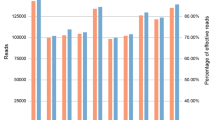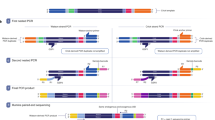Abstract
This protocol describes a single nucleotide polymorphism (SNP) genotyping strategy for highly degraded DNA, using a two-stage multiplex whereby multiple fragments are first amplified in a single exponential reaction and the products of this PCR are added to a linear single-base-extension reaction. It utilizes the analytical power of a capillary electrophoresis system to simultaneously type all the target sites. The protocol is specifically written for use with severely fragmented templates, typical of ancient DNA, and can be adapted to widely used detection platforms. The addition of the single-phase genotyping step avoids the need for the re-amplification and cloning of PCR products, while providing its own controls for the detection of contamination and allelic drop-out. This protocol can facilitate the routine analysis of up to 52 SNP markers (haploid or diploid) in 96 samples in a single day, and is recommended for the authentication of data in all areas of DNA research (population and medical genetics, forensics, ancient DNA).
This is a preview of subscription content, access via your institution
Access options
Subscribe to this journal
Receive 12 print issues and online access
$259.00 per year
only $21.58 per issue
Buy this article
- Purchase on Springer Link
- Instant access to full article PDF
Prices may be subject to local taxes which are calculated during checkout



Similar content being viewed by others
References
Lindblad-Toh, K. et al. Large-scale discovery and genotyping of single-nucleotide polymorphisms in the mouse. Nat. Genet. 24, 381–386 (2000).
Hardenbol, P. et al. Highly multiplexed molecular inversion probe genotyping: over 10,000 targeted SNPs genotyped in a single tube assay. Genome Res. 15, 269–275 (2005).
Anderson, E.C. et al. The power of single-nucleotide polymorphisms for large-scale parentage inference. Genetics 172, 2567–2582 (2006).
Bandelt, H.J. Mosaics of ancient mitochondrial DNA: positive indicators of nonauthenticity. Eur. J. Hum. Genet. 13, 1106–1112 (2005).
Römpler, H. et al. Multiplex amplification of ancient DNA. Nat. Protocols 1, 720–728 (2006).
Syvänen, A.C. From gels to chips: “minisequencing” primer extension for analysis of point mutations and single nucleotide polymorphisms. Hum. Mutat. 13, 1–10 (1999).
Noonan, J.P. et al. Genomic sequencing of Pleistocene cave bears. Science 309, 597–599 (2005).
Smith, C.I. et al. The thermal history of human fossils and the likelihood of successful DNA amplification. J. Hum. Evol. 45, 203–217 (2003).
Quintans, B. et al. Typing of mitochondrial DNA coding region SNPs of forensic and anthropological interest using SNaPshot minisequencing. Forensic Sci. Int. 140, 251–257 (2004).
Brandstätter, A. et al. Dissection of mitochondrial superhaplogroup H using coding region SNPs. Electrophoresis 27, 2541–2550 (2006).
Rachlin, J. et al. Computational tradeoffs in multiplex PCR assay design for SNP genotyping. B.M.C. Genomics 6, 102 (2005).
Umetsu, K. et al. Multiplex amplified product-length polymorphism analysis of 36 mitochondrial single-nucleotide polymorphisms for haplogrouping of East Asian populations. Electrophoresis 26, 91–98 (2005).
Pastinen, T. et al. Minisequencing: a specific tool for DNA analysis and diagnostics on oligonucleotide arrays. Genome Res. 7, 606–614 (1997).
Sanchez, J.J. et al. Multiplex PCR and minisequencing of SNPs - a model with 35 Y chromosome SNPs. Forensic Sci. Int. 137, 74–84 (2003).
Brion, M. et al. Introduction of an single nucleodite polymorphism-based “Major Y-chromosome haplogroup typing kit” suitable for predicting the geographical origin of male lineages. Electrophoresis 26, 4411–4420 (2005).
Sanchez, J.J. et al. A multiplex assay with 52 single nucleotide polymorphisms for human identification. Electrophoresis 27, 1713–1724 (2006).
McKay, S.J. et al. AcePrimer: automation of PCR primer design based on gene structure. Bioinformatics 18, 1538–1539 (2002).
Kaplinski, L. et al. MultiPLX: automatic grouping and evaluation of PCR primers. Bioinformatics 21, 1701–1702 (2005).
Rachlin, J. et al. MuPlex: multi-objective multiplex PCR assay design. Nucleic Acids Res. 33, 544–547 (2005).
Yamada, T. et al. PrimerStation: a highly specific multiplex genomic PCR primer design server for the human genome. Nucleic Acids Res. 34, 665–669 (2006).
Weckx, S. et al. SNPbox: web-based high-throughput primer design from gene to genome. Nucleic Acids Res. 32, 170–172 (2004).
Rozen, S. et al. Primer3 on the WWW for general users and for biologist programmers. Meth. Mol. Biol. 132, 365–386 (2003).
Cooper, A. et al. Ancient DNA: do it right or not at all. Science 289, 1139 (2000).
Pääbo, S. et al. Genetic analyses from ancient DNA. Annu. Rev. Genet. 38, 645–679 (2004).
Vallone, P.M. et al. AutoDimer: a screening tool for primer-dimer and hairpin structures. Biotechniques 37, 226–231 (2004).
Yuryev, A. et al. Predicting the success of primer extension genotyping assays using statistical modeling. Nucleic Acids Res. 30, 131 (2002).
Kaderali, L. et al. Primer-design for multiplexed genotyping. Nucleic Acids Res. 31, 1796–1802 (2003).
Henegariu, O. et al. Multiplex PCR: critical parameters and step-by-step protocol. Biotechniques 23, 504–511 (1997).
Doi, Y. et al. A new method for ABO genotyping using a multiplex single-base primer extension reaction and its application to forensic casework samples. Leg. Med. 6, 213–223 (2004).
Palanichamy, M.G. et al. The dazzling array of basal branches in the mtDNA macrohaplogroup N from India as inferred from complete genomes. Mol. Biol. Evol. 23, 683–690 (2006).
Behar, D. et al. The matrilineal ancestry of Ashkenazi Jews: portrait of a recent founder event. Am. J. Hum. Genet. 78, 487–497 (2006).
Kivisild, T. et al. The role of selection in the evolution of human mitochondrial genomes. Genetics 172, 373–387 (2006).
Bandelt, H.J. et al. More evidence for non-maternal inheritance of mitochondrial DNA? J. Med. Genet. 42, 957–960 (2005).
Salas, A. et al. A practical guide to mitochondrial DNA error prevention in clinical, forensic and population genetics. Biochem. Biophys. Res. Commun. 335, 891–899 (2005).
Author information
Authors and Affiliations
Corresponding author
Ethics declarations
Competing interests
The authors declare no competing financial interests.
Rights and permissions
About this article
Cite this article
Sanchez, J., Endicott, P. Developing multiplexed SNP assays with special reference to degraded DNA templates. Nat Protoc 1, 1370–1378 (2006). https://doi.org/10.1038/nprot.2006.247
Published:
Issue Date:
DOI: https://doi.org/10.1038/nprot.2006.247
This article is cited by
-
The MASTiFF panel—a versatile multiple-allele SNP test for forensics
International Journal of Legal Medicine (2020)
-
Genome-wide screen for universal individual identification SNPs based on the HapMap and 1000 Genomes databases
Scientific Reports (2018)
-
Multiplex genotyping system for efficient inference of matrilineal genetic ancestry with continental resolution
Investigative Genetics (2011)
-
Geografische Herkunftsbestimmung unbekannter DNA-Spuren
Rechtsmedizin (2010)
-
Genotyping human ancient mtDNA control and coding region polymorphisms with a multiplexed Single-Base-Extension assay: the singular maternal history of the Tyrolean Iceman
BMC Genetics (2009)
Comments
By submitting a comment you agree to abide by our Terms and Community Guidelines. If you find something abusive or that does not comply with our terms or guidelines please flag it as inappropriate.



